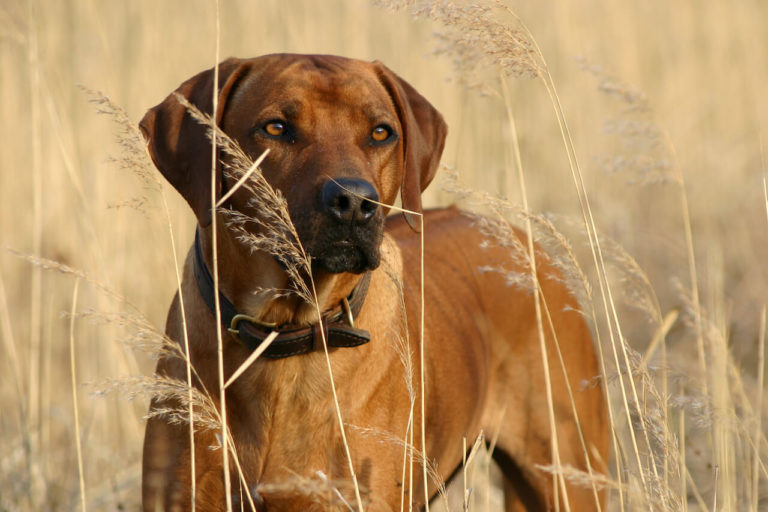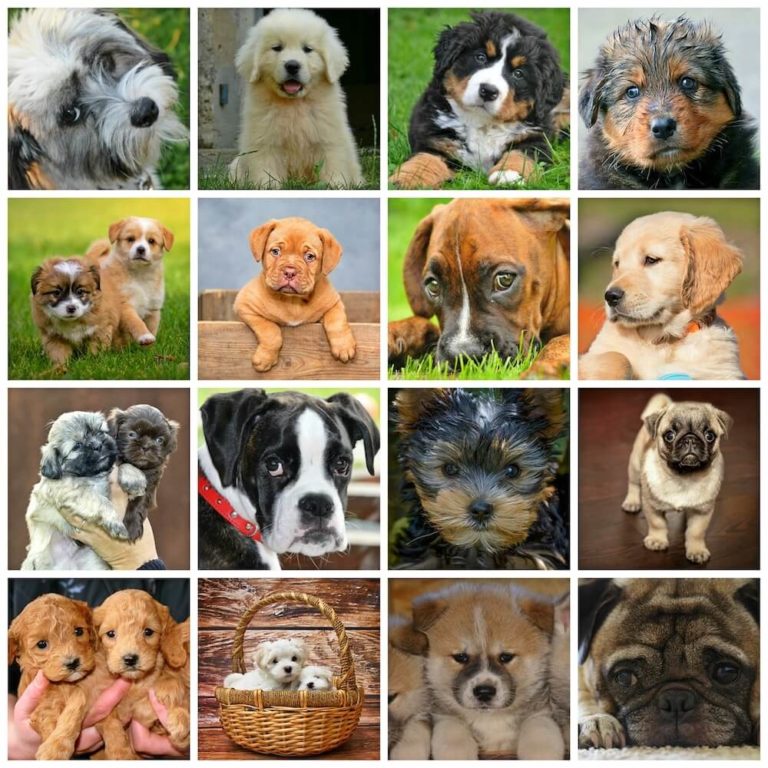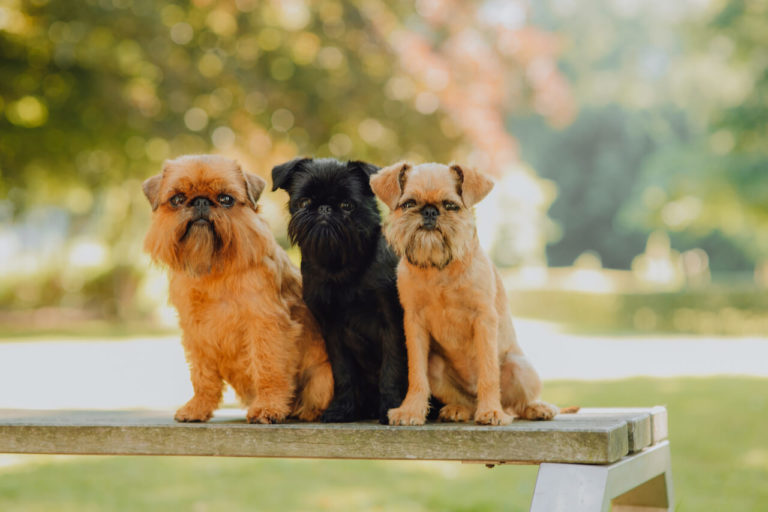






Is the Rhodesian Ridgeback the right dog for you? How much exercise does a Rhodesian Ridgeback need? What do you have to pay special attention to when raising and keeping a Rhodesian Ridgeback? This and more you will find out here.
Breed Description
A Rhodesian Ridgeback is a confident and intelligent everyday companion. He is excellent as a watchful, thinking companion, if you can meet his need for activity.
Origin And Breed History
The Rhodesian Ridgeback is currently the only recognized dog breed originating in South Africa. The origin goes far back into colonial times. The first European settlers at the Cape of South Africa brought their own guard and hunting dogs.
These mixed with the partly domesticated dogs of the ancestral African tribes. Especially the group of the Hottentots and Khoi-Khoi kept dogs with the characteristic back comb.
Since only really healthy dogs had survived the crossing from Europe, a very resistant and strong mixed population developed. The dogs were trained mainly for hunting and learned a hunting behavior in groups.
They tracked big game together and kept it at bay until the hunters arrived. in 1922, Frances Richard Barnes, a Briton, established the breed standard in the then still existing Republic of Rhodesia. Four years later, the breed was recognized internationally. Model for the breed standard were Dalmatians.
Appearance Of The Rhodesian Ridgeback

The ridge is the distinctive trademark of the Rhodesian Ridgeback. Sometimes the ridge is also referred to as the eel line. The importance of this identifying feature went so far in England that breeding regulations required the killing of puppies without a ridge.
The public publication of this regulation caused a scandal – since 2008 this regulation no longer exists.
A ridge is the line of fur that begins between the shoulders and narrows towards the hips.
On this line, which is as central and straight as possible, the coat grows in the opposite direction to the rest of the growth. The back crest should be about 5cm wide. To meet the breeding standard, only a maximum of two vertebrae may provide for the direction of growth.
A Rhodesian Ridgeback is a muscular, lean and very well proportioned dog. The dog’s activity and stamina should be visually apparent from a distance. Symmetry and functionality are the main focus of the appearance.
The strong back blends into slightly arched, muscular loins. The chest is deep and broad, the lowest point of the sternum being approximately at the level of the elbows. The forechest must be visible from the side. The rib arches are only slightly curved, never round.
The tail is mid-set, often slightly curved towards the end, never curled. A Rhodesian Ridgeback has a heavy and strong tail, which becomes only slightly narrower towards the end.
The strong long neck is taut and without neck wrinkles. There are no wrinkles on the head either – the elegant smart head has a clearly visible nose leather and taut flews. The eyes of the Rhodesian Ridgeback are relatively wide apart and harmonize with the coat color.
The coat is glossy, short and dense, neither soft nor curly. A Rhodesian Ridgeback has no undercoat. Rarely, Ridgebacks have white markings in the coat, but it is allowed in breeding. The coat color is chestnut brown, wheat yellow or chestnut red.
The nose and muzzle may be black, and there is sometimes black coloring on the tips of the ears as well. The ears are set high on the head, triangular in shape and floppy.
Character And Temperament
A Rhodesian Ridgeback is a classic working dog. He is active and persistent – but also needs a lot of sleep breaks. Character-wise, two traits stand out clearly: the hunting instinct and the protective instinct. The Rhodesian Ridgeback is a very intelligent, confident dog that has tracked down lions, hunted them down and defended its owner against them.
So it is a brave, fearless dog that is used to making decisions on its own. It performs its duties very conscientiously with the right education, it is unconditionally loyal to humans and defends its caregivers without regard for its own integrity.
The reticence towards strangers is not shyness or aggressiveness – it is rather disinterest. The irritation threshold of a Rhodesian Ridgeback is in the middle range.
The Rhodesian Ridgeback has no great play instinct, but likes to cuddle and is quite sensitive to its environment. Submissive is a Rhodesian Ridgeback not, but loyal, attentive and willing to learn.
Especially a young Ridgeback is full of impetuous energy, which should be directed into the right channels.
Husbandry And Diet
Attitude
The Rhodesian Ridgeback does not necessarily need a house with a garden – but he needs a lot of exercise! You don’t have to exercise your dog around the clock, but two hours of exercise a day is necessary. By “exercise” we don’t mean casual walking – a Rhodesian Ridgeback is an ideal jogging companion and also runs well alongside a bicycle.
Because of the strong hunting instinct, it is not wise to let him run free in the woods. He is very well suited for various work-intensive dog sports, as he is intelligent and eager. Agility, mantrailing, nose work – these are his best occupations.
However, you should wait with such sports until the dog is at least a year, better even older. The Rhodesian Ridgeback is not really mature and serious enough to do the sport confidently until it is about 3 years old.
In Bavaria, the Rhodesian Ridgeback was on the list of dangerous dogs from 1992-2002, and in Switzerland and Austria special certificates are required to obtain a keeping permit.
Diet
The diet of a Rhodesian Ridgeback is uncomplicated, he does not make great demands on food. Since he was bred as a hunting dog, BARF is often a good choice, but then attention must be paid to the addition of vitamins and other nutrients.
Dry food or ready mixes are sometimes well tolerated, but will harm the coat. Since the coat is very short, scaly and bald patches are an unfortunate nuisance for the dog.
The short coat is meant for South African sun. Therefore, in winter, the Rhodesian Ridgeback definitely needs a coat! The dog is happy to have a warm place in the home, ideally with underfloor heating.
A Rhodesian Ridgeback that is clearly active 2-3 hours a day will happily sleep up to 21 hours a day.
Education And Care
Education
One thing you should be aware of: A Rhodesian Ridgeback is not a cuddly beginner dog! The breed is not submissive or easily tricked. The dogs are smart and confident. So you need to be smarter and more confident and very clear in your orders.
The Rhodesian Ridgeback respects other people, but must be handled with consistency. Because he is very protective, it is often not easy, especially for females, to deal with an unneutered male alone – males are much more protective of females than males.
Conversely, bitches are often very dominant in their behavior and, if you let them, will take a diva position in the household. This is not to scare you off, it is just to make you aware that a Rhodesian Ridgeback is a dog of character.
With a Rhodesian Ridgeback you do not have a high-maintenance dog, but the education is a demanding task. If you succeed in training, you will have a very affectionate companion who will accompany you throughout his life.
Care
The only time you will have to groom your dog is during the shedding season, when you will have to groom him regularly for two weeks. On the dog run it quickly becomes clear that a Rhodesian Ridgeback is not a play dog. He wants to protect and encourage others to hunt.
Male dogs often get along well with strange females, same-sex encounters require increased attention from owners. If the Rhodesian Ridgeback grows up with cats and small animals, this can work well.
Getting to know them later will rarely be successful – cats and small animals are more likely to be chased. With horses or other large animals, a Rhodesian Ridgeback usually gets along well.
If you have a family with small children, a Ridgeback puppy is not suitable. Not because he might be aggressive towards the children, but rather because he is so impetuous.
Also, children who are nearing puberty and will be joining the dog in the flailing years may have a hard time asserting themselves against the dog.
Health And Typical Diseases
In general, the Rhodesian Ridgeback is a healthy, strong dog that is also rarely prone to allergies. However, there are always difficulties with dermoid cysts.
Dogs with this disease must not be used for breeding, otherwise agonizing effects on offspring are to be feared. A dermoid cyst develops under the skin at the end of the dorsal line. It can occur when the coat and spinal cord are not clearly separated and need not be visible from the outside.
These cysts can cause paralysis and mechanical hypersensitivity. Presumed cause is a gene defect linked to the genetic information of the ridge, so this disease can occur even in the best of breedings.
Symmetric Lupoid Onychodystrophy is an autoimmune disease to which the Rhodesian Ridgeback can be prone. Most often, this disease results in brittle claws and painful gait .
Omega-3 fatty acids and biotin seem to play a role in the diet, so many Ridgeback owners feed this in addition.
A Rhodesian Ridgeback will slow down with age, but is not prone to many signs of aging.
Mostly the need for sleep becomes greater, but alertness remains unaffected. Healthy Rhodesian Ridgebacks still enjoy jogging at 12 years of age.
Life Expectancy

A Rhodesian Ridgeback is a companion for many years. Provided there are no illnesses, he can live to be about 12 years old if kept well, sometimes older.
Buy Rhodesian Ridgeback Dog Breed
Especially such a demanding and characterful dog as the Rhodesian Ridgeback should definitely be purchased from reputable breeding. Again and again such dogs end up in animal shelters, and a traumatized and badly socialized Rhodesian Ridgeback is no walker dog.
You can recognize a good breeding by the fact that you can visit the mother and the puppies together and the breeder will choose you. A serious breeder will not give his puppies into inexperienced or unsuitable hands.
Decision Support
You have read all this now and you think a Rhodesian Ridgeback is the ideal dog for you? Congratulations! If you are a little unsure, make a pro/con list.
The dog needs a lot of attention, a confident owner and consistent training. Does this apply to you? Then go for it If you have never had a dog before, have small children or are a very shy person, however, you should reconsider your decision.
FAQ Rhodesian Ridgeback
A Rhodesian Ridgeback lives between 11 and 14 years.
A Rhodesian Ridgeback costs between 1,400 and 2,500 euros.
Rhodesian Ridgebacks live up to 14 years.
A Rhodesian Ridgeback usually grows in for 12 to 16 months.
Up to 50 km/ h these dogs can run fast.
Exercise and plenty of exercise are very important for these dogs. This should definitely be considered before buying. He is best accommodated in a large house with a garden. He should also be mentally challenged again and again.
Dogs are They are pack animals and should therefore not be left alone for long periods of time. They need the company of their owners. You should not be alone for longer than 4 hours. In addition, the Rhodesian Ridgeback needs a lot of exercise.
Patience, perseverance and consistency are very important when training any dog.
Rhodesian Ridgebacks shed all year round. Therefore, it makes sense to brush out the coat every day. Otherwise, the short coat of the dogs is very easy to care for.
A Rhodesian Ridgeback is 61 to 69 cm tall.













